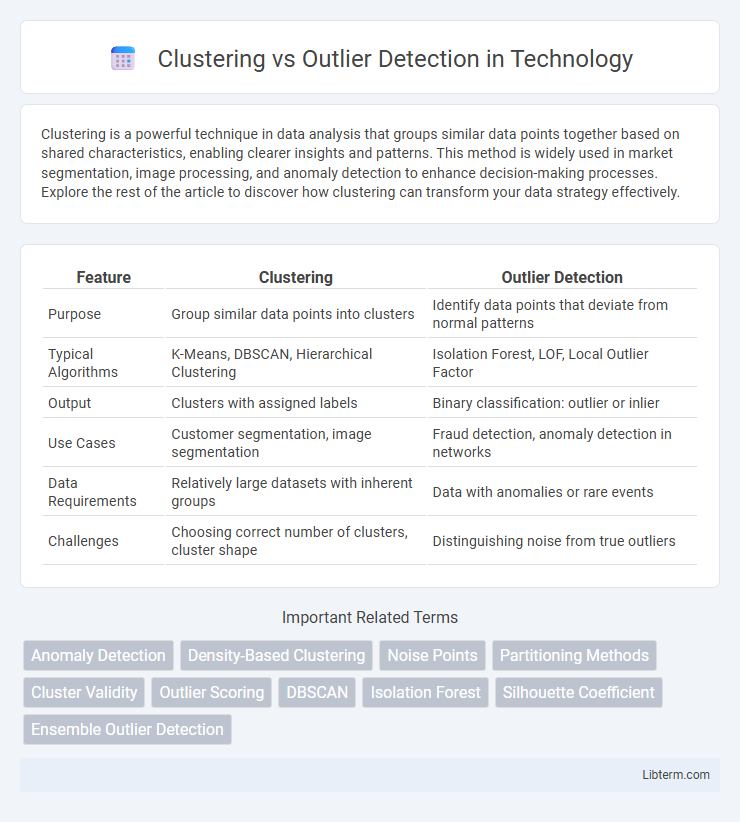Clustering is a powerful technique in data analysis that groups similar data points together based on shared characteristics, enabling clearer insights and patterns. This method is widely used in market segmentation, image processing, and anomaly detection to enhance decision-making processes. Explore the rest of the article to discover how clustering can transform your data strategy effectively.
Table of Comparison
| Feature | Clustering | Outlier Detection |
|---|---|---|
| Purpose | Group similar data points into clusters | Identify data points that deviate from normal patterns |
| Typical Algorithms | K-Means, DBSCAN, Hierarchical Clustering | Isolation Forest, LOF, Local Outlier Factor |
| Output | Clusters with assigned labels | Binary classification: outlier or inlier |
| Use Cases | Customer segmentation, image segmentation | Fraud detection, anomaly detection in networks |
| Data Requirements | Relatively large datasets with inherent groups | Data with anomalies or rare events |
| Challenges | Choosing correct number of clusters, cluster shape | Distinguishing noise from true outliers |
Introduction to Clustering and Outlier Detection
Clustering partitions data into distinct groups based on similarity, revealing underlying patterns and structures without pre-labeled outcomes. Outlier detection identifies data points that deviate significantly from the norm, often signaling rare events or anomalies. Both techniques serve in exploratory data analysis, with clustering aiding in pattern discovery and outlier detection enhancing data quality and anomaly identification.
Defining Clustering: Grouping Similar Data
Clustering is the process of grouping similar data points into clusters based on shared characteristics or features, enabling the identification of natural structures within datasets. Algorithms such as k-means, hierarchical clustering, and DBSCAN quantify similarity through distance metrics like Euclidean or cosine distance to optimize cluster formations. Effective clustering enhances data analysis by revealing underlying patterns and facilitating tasks like customer segmentation, image recognition, and anomaly detection.
Understanding Outlier Detection: Finding the Unusual
Outlier detection involves identifying data points that significantly deviate from the normal patterns within a dataset, which is critical for tasks such as fraud detection, network security, and quality control. Unlike clustering, which groups similar data points to reveal underlying structures, outlier detection focuses on spotting anomalies or rare events that may indicate errors or novel insights. Effective outlier detection techniques include statistical methods, distance-based approaches, and machine learning models, all aimed at accurately distinguishing unusual data from normal variations.
Key Differences Between Clustering and Outlier Detection
Clustering groups data points based on similarity to identify inherent structures within datasets, while outlier detection targets rare or anomalous data that deviate significantly from the norm. Clustering algorithms like K-means or DBSCAN partition data into cohesive clusters, whereas outlier detection methods such as Isolation Forest or Local Outlier Factor (LOF) focus on identifying points that do not conform to expected patterns. Key differences include objectives--clustering aims at pattern discovery and grouping, while outlier detection emphasizes anomaly identification for data quality or fraud detection.
Common Algorithms Used in Clustering
Common clustering algorithms include K-means, Hierarchical clustering, and DBSCAN, each offering unique approaches to grouping data based on similarity. K-means partitions data into K distinct clusters by minimizing variance within clusters, while Hierarchical clustering builds nested clusters through agglomerative or divisive methods. DBSCAN identifies dense regions in data, effectively discovering clusters of arbitrary shape and detecting noise points simultaneously.
Popular Methods for Outlier Detection
Popular methods for outlier detection include statistical approaches such as Z-score and Grubbs' test, distance-based methods like k-nearest neighbors (k-NN), and density-based algorithms exemplified by Local Outlier Factor (LOF). Ensemble techniques that combine multiple detection methods enhance robustness and accuracy in identifying anomalies. Machine learning models, especially isolation forests and autoencoders, have become widely adopted for their ability to uncover complex outlier patterns in high-dimensional data.
Practical Applications of Clustering
Clustering organizes data into meaningful groups, enabling market segmentation, customer profiling, and targeted marketing strategies to improve business outcomes. It is widely used in image segmentation for medical diagnostics, grouping similar patterns to enhance disease detection accuracy. In fraud detection, clustering identifies abnormal transaction clusters, helping to uncover potential fraudulent activities efficiently.
Real-World Uses of Outlier Detection
Outlier detection plays a critical role in real-world applications such as fraud detection in financial transactions, where identifying anomalous spending patterns prevents unauthorized activities. In healthcare, it aids in diagnosing rare diseases by flagging atypical patient data that deviates from normal clinical measurements. Manufacturing industries use outlier detection to monitor equipment performance, detecting deviations that signal potential failures before they cause costly downtime.
Challenges and Limitations of Each Approach
Clustering faces challenges in handling high-dimensional data, which often leads to reduced accuracy and difficulty in defining cluster boundaries, especially in noisy or overlapping datasets. Outlier detection struggles with distinguishing true anomalies from rare but valid patterns, resulting in high false positive rates and sensitivity to parameter settings. Both approaches require careful tuning and domain knowledge to effectively balance detection performance and computational complexity.
Choosing Between Clustering and Outlier Detection
Choosing between clustering and outlier detection depends on the primary objective of data analysis: clustering groups similar data points to identify underlying patterns or segmentations, while outlier detection focuses on identifying anomalies or rare events that deviate significantly from the norm. Clustering algorithms like K-means, DBSCAN, and hierarchical clustering excel when the goal is to discover natural groupings within the dataset. Outlier detection techniques such as Isolation Forest, Local Outlier Factor, and statistical methods are preferable when pinpointing rare or suspicious data points critical for fraud detection, network security, or error identification.
Clustering Infographic

 libterm.com
libterm.com